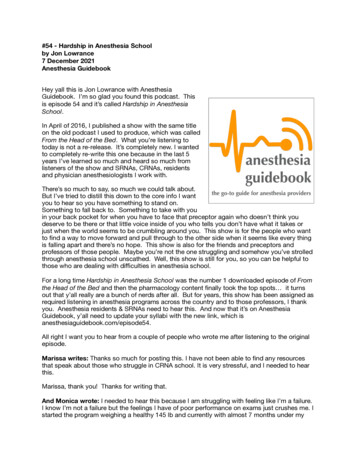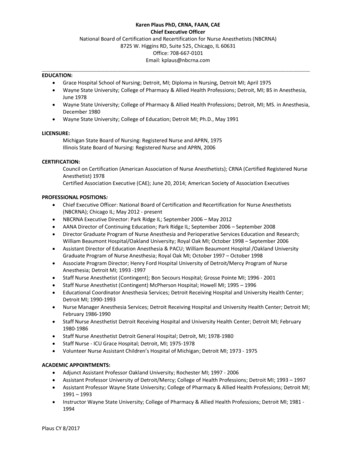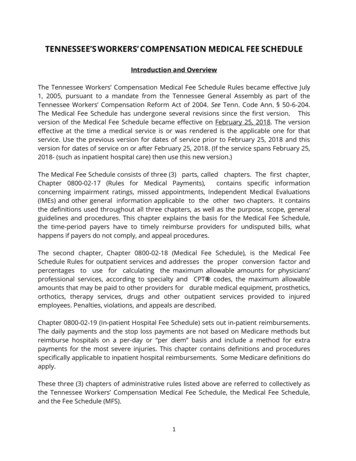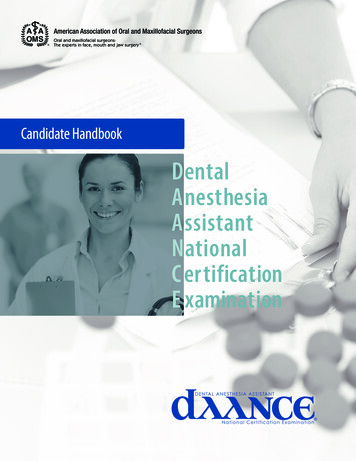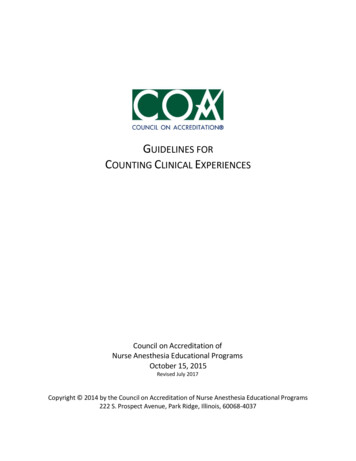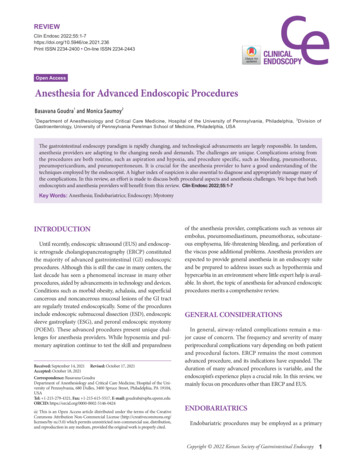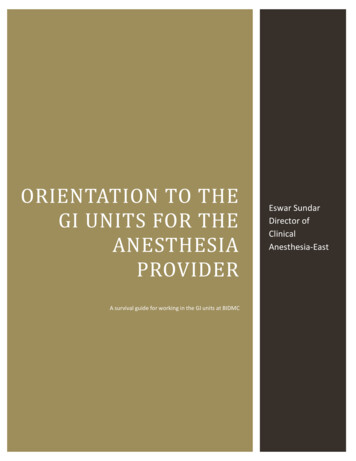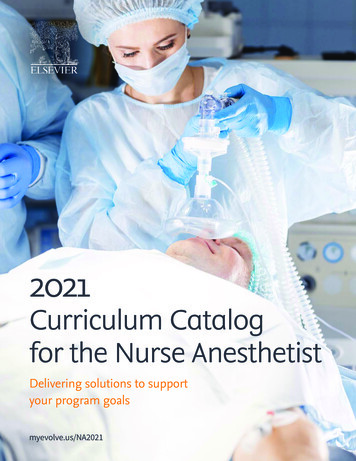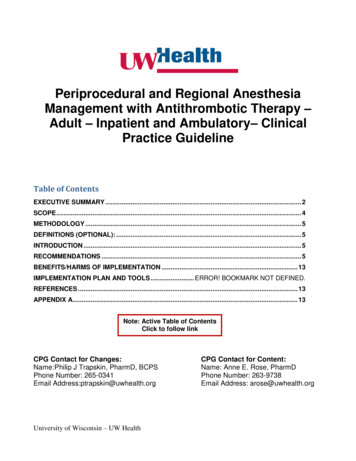
Transcription
Periprocedural and Regional AnesthesiaManagement with Antithrombotic Therapy –Adult – Inpatient and Ambulatory– ClinicalPractice GuidelineTable of ContentsEXECUTIVE SUMMARY . 2SCOPE . 4METHODOLOGY . 5DEFINITIONS (OPTIONAL): . 5INTRODUCTION . 5RECOMMENDATIONS . 5BENEFITS/HARMS OF IMPLEMENTATION . 13IMPLEMENTATION PLAN AND TOOLS . ERROR! BOOKMARK NOT DEFINED.REFERENCES . 13APPENDIX A. 13Note: Active Table of ContentsClick to follow linkCPG Contact for Changes:Name: Philip J Trapskin, PharmD, BCPSPhone Number: 265-0341Email Address:ptrapskin@uwhealth.orgUniversity of Wisconsin – UW HealthCPG Contact for Content:Name: Anne E. Rose, PharmDPhone Number: 263-9738Email Address: arose@uwhealth.org
Guideline Author(s) (if applicable):Anne Rose, PharmD – Anticoagulation StewardshipCoordinating Team Members:David Ciske, MD – Medical Director: Anticoagulation Clinic and Internal MedicineErin Robinson, PharmD, CACP – Anticoagulation ClinicPatrick Pfau, MD – GastroenterologyMichael Ford, MD – AnesthesiaKristopher Schroeder, MD – AnesthesiaReview Individuals/Bodies:Inpatient Anticoagulation CommitteeAmbulatory Anticoagulation CommitteeCommittee Approvals/Dates:Anticoagulation Committees: November 2012; August 2015Pharmacy and Therapeutics: February 2013Release Date:Original: October 2011Revised: February 2013; August 2015Next Review Date:October 2017University of Wisconsin – UW Health
Executive SummaryGuideline OverviewThe following guideline provides recommendations for patients receiving antithrombotic therapy andwho require surgery, other invasive procedures, neuraxial or peripheral nerve procedures. Evaluatingthromboembolic and bleeding risks are outlined, as well as considerations for administeringantithrombotic therapy in the periprocedural setting and prior to regional anesthesia placement andremoval.Target PopulationInpatient and ambulatory adult patients who have indication(s) for antithrombotic medications andrequire either a surgical procedure and/or the need for neuraxial analgesia.Key Practice Recommendations1. The use of periprocedural bridging with antithrombotic agents should be reserved for highthrombotic risk patients.2. Each antithrombotic agent has individual recommendations for how long it should be held preprocedure, so advanced planning (in a non-emergent situation) is recommended.3. Antithrombotic therapy should be resumed post procedure when hemostasis is achieved andthe risk for bleeding has minimized.4. Most antithrombotic agents should not be given during neuraxial anesthesia.5. Each antithrombotic agent has individual recommendations for how long it should be held preand post spinal epidural catheter placement and removal, so a medication review of bothactive and inactive antithrombotic medications is recommended.Companion DocumentsUW Health Procoagulant Clinical Practice GuidelinePertinent UWHC Policies & ProceduresUW Health Administrative Policy 8.92: Epidural and Intrathecal (Neuraxial) AnalgesiaPatient Resources:Health Facts For You #4322: Epidural AnalgesiaHealth Facts For You #5915: Spinal Analgesia for Chronic PainHealth Facts For You #6115: Stopping Anticoagulation and Antiplatelet TherapyHealth Facts For You #6404: Medicines, Herbs, and Vitamins Which Affect BleedingHealth Facts For You #6915: Heparin (Unfractionated and Low Molecular Weight)University of Wisconsin – UW Health
ScopeDisease/Condition(s):Any disease or condition that would necessitate the need for anticoagulant, antiplatelet, orthrombolytic therapy. (ex. atrial fibrillation, cardiac disease, stroke)Clinical Specialty:Surgical servicesProceduralistsAnesthesia Pain ServicePrimary care providersAnticoagulation clinicIntended Users:PhysiciansAdvanced Practice ProvidersPharmacistsNursesCPG objective(s):To assist clinicians by providing recommendations for holding, bridging and resuming antithrombotictherapy for procedures and holding, administering and resuming antithrombotic therapy for neuraxialanalgesia.Target Population:Inpatient and ambulatory adult patients who have indication(s) for antithrombotic medications andrequire either a surgical procedure and/or the need for neuraxial analgesia.Interventions and Practices Considered:This guideline contains strategies and recommendations designed to assist clinicians in developingperiprocedural antithrombotic management plans. It begins with providing recommendations on howto identify patients who are in need of periprocedural bridging based on thrombosis and bleedingrisks. It focuses on antithrombotic medications by drug class (ex. anticoagulant, antiplatelet andthrombolytic) and provides recommendations for holding prior to surgery/procedure and when toresume therapy (if indicated). The second half of the guideline provides recommendations for holdingantithrombotic agents prior to spinal/epidural catheter placement. It also provides recommendationsfor when to resume therapy (if indicated) after catheter removal.Major Outcomes Considered:Thromboembolic events in the absence of antithrombotic therapy in the periprocedural settingHemorrhagic events with antithrombotic therapy in the periprocedural settingHemorrhagic events with antithrombotic therapy with epidural or spinal catheter placement andremovalGuideline Metrics:Metrics will include appropriate patient selection for “bridge” therapy, thromboembolic event up to 30days after procedure, bleeding event up to 30 days after procedure, appropriate hold time ofantithrombotic in relation to procedure or neuraxial catheter placement or removal and inappropriateadministration of antithrombotic medications during neuraxial catheter placement.University of Wisconsin – UW Health
MethodologyMethods Used to Collect/Select the Evidence:(1) completing a comprehensive literature search of electronic databases; (2) conducting an in-depthreview of relevant abstracts and articles; (3) conducting thoughtful discussion and interpretation offindings; (4) ranking strength of evidence underlying the current recommendations that are made.Methods Used to Assess the Quality and Strength of the Evidence:The same grading system for recommendations from the American Society of Regional Anesthesiaand Pain Medicine Evidence-Based Guidelines was utilized.Rating Scheme for the Strength of the Evidence and Recommendations:For all other recommendations a modified Grading of Recommendations Assessment, Developmentand Evaluation (GRADE) developed by the American Heart Association and American College ofCardiology (Figure 1.) has been used to assess the Quality and Strength of the Evidence in thisClinical Practice Guideline.1 See Appendix A.Definitions1. Periprocedural or Bridging Anticoagulation – administration of a short acting anticoagulantduring the interruption of long-term antithrombotic therapy for major/minor surgery orprocedures. Usually administered for a 10-12 day period.22. Regional anesthesia – includes techniques and administration of analgesics through the epiduralor intrathecal routes. Also referred to as neuraxial analgesia or spinal/epidural analgesia.3. Antithrombotic therapy – includes any anticoagulant or antiplatelet medicationIntroductionPatients receiving long term antithrombotic therapy who require surgery or an invasive procedurepresent a difficult therapeutic dilemma for clinicians. In this periprocedural interval whenantithrombotic therapy is halted, periprocedural anticoagulation (bridging therapy) with a heparinproduct may be recommended for some patients.2,3 There is new evidence to support the use ofbridging therapy in a small group of high risk patients which has been outlined in this guideline.Studies have shown an increase in bleeding events when bridging therapy with a heparin agent wasused both before and after procedures, with no difference in the incidence of thromboembolic events,compared to patients who did not receive bridging therapy around the time of procedures.4-5The use of antithrombotics for venous thromboembolism (VTE) prevention, VTE treatment, cardiacand vascular disease, and the use of thrombolytics can increase the risk of spinal hematoma if thesemedications are not appropriately held prior to, during and after removal of an epidural catheter.Spinal hematoma, while rare, is a serious complication that is closely associated with antithromboticadministration during spinal and epidural analgesia.6This guideline will be separated into 2 sections for antithrombotic management: Periprocedural andNeuraxial Anesthesia.University of Wisconsin – UW Health
RecommendationsPeriprocedural Antithrombotic Management1. Weigh the consequences of short-term risk for thromboembolism and bleeding for the individualpatient.21.1. Very few patients will need periprocedural anticoagulation or bridging therapy4-5(Class IIa, Level B).1.2. Overall risk stratification should focus on the patient's risk of thromboembolism since theconsequences of a thromboembolic event are more likely to have serious, lasting effectsthan compared to consequences of major bleeding2-3. (Class IIa, Level C)1.3. Use Table 1 to evaluate the bleeding risk of procedure or surgery2 (Class IIa, Level C)1.4. Use Table 2 to identify patients at risk for systemic embolism if antithrombotic agent isdiscontinued2-5 (Class IIa, Level C)1.4.1. It is recommended to use periprocedural (bridge) therapy for patients identified inTable 2.2-5 (Class IIa, Level B)1.5. Endoscopic procedures1.5.1. For low thromboembolic risk patients: for warfarin hold and proceed with endoscopicprocedure when the INR 1.5 and for other anticoagulants see specificrecommendations in Tables 4-8.2,7,8(Class IIa, Level C)1.5.2. For high thromboembolic risk patients: see Table 3. Hold anticoagulation based onspecific recommendations for each drug listed in Tables 4-8. 2,7,8(Class IIa, Level B)2,8,9Table 1. Bleeding Risk for Surgery/ProcedureBleed RiskSurgery/Procedure TypeHigh Aortic aneurysm repair Bladder surgery Bowel polypectomy Coronary artery bypass grafting (CABG) Heart valve replacement Intracranial surgery Major cancer surgery Major orthopedic surgery (hip or knee replacement) Peripheral artery bypass and other major vascular surgery Prostate surgery Reconstructive plastic surgery Spinal surgery/Epidural procedureModerate Renal biopsy Resection of colon polyps Prostate biopsy Pacemaker or defibrillator implantation Major intraabdominal surgery Major intrathoracic surgery More invasive dental or ophthalmic proceduresLow Cataract surgery Dental proceduresDental hygieneSimple extractionsRestorationsEndodonticsProsthetics Cutaneous surgeries (most)University of Wisconsin – UW Health
Laparoscopic cholecystectomy or hernia repairCoronary angiographyEndoscopy with or without biopsyColonoscopy with or without biopsy2,4,5,10Table 2. Periprocedural Risk for ThromboembolismRiskHigh:Periprocedural Anticoagulation advisedMechanical Heart Any mechanical mitral valveValve Older mechanical valve model (caged ball or tilting disc) in mitral oraortic position Recently placed mechanical valve ( 3 months) in mitral or aorticposition Recent stroke or TIA (within 6 months) with mitral or aortic valveAtrial Fibrillation With mechanical heart valve in mitral or aortic position With recent stroke or TIA (within 3 months)VenousThromboembolism VTE within previous 3 months2,8,9Table 3. Anticoagulation Considerations for Endoscopic ProceduresEndoscopic ProcedureHigh Thromboembolic RiskDiagnostic or ScreeningHold anticoagulation*Determine if peri-procedural bridging is neededLow biopsy riskHold anticoagulation*Removal of 10 mm polyps with coldDetermine if peri-procedural bridging is neededsnare or forcepsLarge polyp removal ( 10 mm)Hold anticoagulation*Determine if peri-procedural bridging is neededSphincterotomyEsophageal DilationFine Needle AspirationHold anticoagulation*Determine if peri-procedural bridging is needed*See individual anticoagulant recommendations for holding prior to procedure2. Warfarin2,9-112.1. Assess INR at least 7 days before surgery or procedure to allow for planning ofperioperative management. (Class IIa, Level C)2.2. Warfarin may be continued during procedures where bleed risk is low.2,9,2.2.1. Simple dental procedures (including extractions) if there is coadministration of anoral prohemostatic agent. (If no oral prohemostatic agent is coadministered, thenwarfarin should be held for 2-3 days before the procedure) (Class IIa, Level B)2.2.2. Cataract surgery (Class IIa, Level C)2.2.3. Diagnostic or screening colonoscopies (Class IIa, Level C)2.2.4. Some cutaneous surgeries (Class IIa, Level C)2.2.5. For endoscopic procedures – see Table 3 (Class IIa, Level B)2.3. Check INR within 24 hours of surgical procedure to ensure that INR goal has beenattained.2 (Class IIa, Level C)University of Wisconsin – UW Health
2.4. If timing does not allow for gradual reduction of INR from withholding warfarin alone,administration of phytonadione (vitamin K), fresh frozen plasma, or prothrombin complexconcentrates may be necessary. (Class IIb, Level C)Table 4 Periprocedural planning for warfarin2,9-11 (Class I, Level C)DrugWarfarinPre-procedureINR2.0 – 3.0Pre-Procedure PlanPost Procedure PlanStop 5 days before procedure3.0 – 4.5Stop 6 days before procedureWithin 24 hours after surgicalprocedure or on postoperative day1 if hemostasis is achieved and ifapproved by surgeon 4.5Stop 6-7 days before procedureConsider rechecking INR after 2-3days of held dosesIf indicated consider phytonadione3. Direct Oral Anticoagulants2,3,12-15 – Listed Alphabetically3.1 Assess renal function at least 7 days before surgery to allow for planning of perioperativemanagement. Pre-operative parenteral anticoagulation (bridging) is not needed. (ClassIIb, Level C)3.2 If timing does not allow for reversal of anticoagulant effect from withholding doses alone,administration of procoagulant agents may be necessary.(Class IIb, Level C)3.3 Tables 5 and 6 provide recommendations for periprocedural managementTable 5 Pre-procedural planning for the direct oral anticoagulants12-15 (Class IIb, Level cedurerenal functionScr 1.5 mg/dLMinor surgery or Standard bleedrisk surgeryStop 24 hours before procedureMajor surgery or high bleed risksurgeryStop 48 hours before procedureScr 1.5 mg/dLStop 48 hours before procedureStop 72 hours before procedureCrCl 50 mL/minStop 1 to 2 days before procedureStop 2 to 4 days before procedureCrCl 50 mL/minStop 3 to 5 days before procedureStop 5 days before procedureCrCl 50 mL/minStop 24 hours before procedureStop 48 hours before procedureCrCl 50 mL/minStop 48 hours before procedureStop 72 hours before procedureCrCl 30 mL/minStop 24 hours before procedureStop 48 hours before procedureCrCl 30 mL/minStop 48 hours before procedureStop 72 hours before procedureUniversity of Wisconsin – UW Health
Table 6 Post-procedural planning for the direct oral anticoagulants12-15 (Class IIb, Level C)DrugApixabanDabigatranEdoxabanRivaroxabanMinor surgery or Standardbleed risk surgeryWithin 24 hoursif approved by surgeonMajor surgery or highbleed risk surgeryWithin 72 hoursif approved by surgeonOnset ofanticoagulation3 – 5 hoursWithin 24 hoursif approved by surgeonWithin 24 hoursif approved by surgeonWithin 24 hoursif approved by surgeonWithin 72 hoursif approved by surgeonWithin 72 hoursif approved by surgeonWithin 72 hours ifapproved by surgeon2 hours2 hours2 – 4 hours4. Parenteral Anticoagulants2,9,11,16-20 – Listed Alphabetically4.1 Parenteral anticoagulation may be used for periprocedural anticoagulation management(bridging) in certain high risk patients.4.2 If timing does not allow for reversal of anticoagulant effect from withholding doses alone,administration of reversal agents or procoagulant agents may be necessary.(Class IIb,Level C)4.3 Tables 7 and 8 provide recommendations for periprocedural management4.4 Appendix B provides dosing recommendations for parenteral anticoagulantsTable 7 Pre-procedural planning for parenteral anticoagulants16-20 (Class IIb, Level C)DrugArgatrobanPre-procedureNormal hepatic functionChild-Pugh Score 6Any bleed risk surgeryStop 3 hours before procedureStop 9 hours before procedureBivalirudinCrCl 30 mL/minCrCl 30 mL/minStop 1.5 hours before procedureStop 3 hours before procedureEnoxaparinProphylactic DosingTherapeutic DosingStop 12 hours before procedureStop 24 hours before procedureFondaparinuxCrCl 50 mL/minCrCl 50 mL/minStop 3 days before procedureStop 5 days before procedureUnfractionated HeparinProphylactic DosingTherapeutic DosingMay give the morning before procedureStop 4-6 hours before procedureTable 8 Post-procedural planning for parenteral anticoagulants16-20 (Class IIb, Level nfractionatedHeparinMinor surgery or Standardbleed risk surgeryWithin 12 hoursif approved by surgeonWithin 12 hoursif approved by surgeonWithin 24 hoursif approved by surgeonMajor surgery or highbleed risk surgeryWithin 24 hoursif approved by surgeonWithin 24 hoursif approved by surgeonWithin 72 hoursif approved by surgeonOnset ofanticoagulation30 minutesWithin 24 hoursif approved by surgeonWithin 12 hours is approved bysurgeonWithin 72 hours ifapproved by surgeonWithin 24 hoursif approved by surgeon3 hoursUniversity of Wisconsin – UW Health15 minutes3 – 5 hoursImmediate
5. Antiplatelet Therapy2,21-23 – Listed Alphabetically5.1 For periprocedural management of antiplatelet therapy, assess use at least 7 daysbefore surgery or procedure to allow for adequate hold time. (Class IIb, Level C)5.2 If timing does not allow for reversal of antiplatelet effect from withholding doses alone,the surgeon may still elect to proceed with surgical procedure. (Class IIb, Level C)5.2.1 Patients with coronary artery stent requiring surgery it is recommended to defersurgery for at least 6 weeks after stent placement.2 (Class I, Level C)5.3 Table 9 provide recommendations for periprocedural managementTable 9 Periprocedural management for antiplatelet drugs2,21-23 (Class IIb, Level B)DrugAspirin(low cardiovascular event risk)Pre-Procedure PlanStop 7-10 days before procedurePost-Procedure PlanWithin 24 hoursif approved by surgeonAspirin(high cardiovascular event risk)May continue aspirinWithin 24 hoursif approved by surgeonClopidogrelStop 5 days before procedureWithin 24-48 hoursif approved by surgeonCilostazolStop 1 -2 days before procedureWithin 24 hoursif approved by surgeonDipyridamoleStop 1 -2 days before procedureWithin 24 hoursif approved by surgeonPrasugrelStop 5-7 days before procedureWithin 24-48 hoursif approved by surgeonTicagrelorStop 5 days before procedureWithin 24-48 hoursif approved by surgeonNeuraxial Anesthesia and Antithrombotic ManagementSpinal hematoma, while rare, is a serious complication of spinal or epidural anesthesia. Risk factorsfor the development of spinal hematoma include: advanced age, underlying coagulopathy, difficultneedle placement and administration of antithrombotic agents with an indwelling neuraxial catheter.To reduce the risk of spinal hematoma related to antithrombotics, administration of these agentsshould be timed appropriately when neuraxial anesthesia is initiated, continued and/or removed.66. Anticoagulants– Listed alphabetically6.1. Prior to initiating neuraxial anesthesia a review of the patient medication list, both currentand prior to admission lists, should be reviewed for use of an anticoagulant. 6 (Class I,Level C)6.2. Utilize Table 10 for recommendations on holding anticoagulants prior to spinal/epiduralcatheter placement, use of anticoagulants during neuraxial therapy, and for resuminganticoagulation after spina/epidural catheters have been removed.6.2.1. No anticoagulant may be administered unless approved by the Anesthesia PainService (APS). (Class I, Level C)University of Wisconsin – UW Health
6.2.2. Unfractionated heparin (subcutaneously) up to doses of 5,000 units every 8-12hours have been approved for use by the APS (Class IIb, Level C)Table 10 Anticoagulant management for spinal/epidural analgesia6,12-15(Class IIb, Level C)DrugApixabanPrior to placementHold 3 daysWhile in placeContraindicatedAfter removal*Restart after minimum of 6 hrsArgatrobanHold 3 hours or until aPTT 35secondsContraindicatedRestart after minimum of 6 hrsBivalirudinHold 3 hours or until aPTT 35secondsContraindicatedRestart after minimum of 6 hrsDabigatranHold 5 daysContraindicatedRestart after minimum of 6 hrsEdoxabanHold 3 daysContraindicatedRestart after minimum of 6 hrsEnoxaparinHold for 12 hours (CrCl 30 mL/min) ContraindicatedHold for 24 hours (CrCl 30 mL/minor after therapeutic dose)Restart after minimum of 6 hrsFondaparinuxHold 48 hours (CrCl 50 mL/min)Hold 72 hours (CrCl 50 mL/min)ContraindicatedRestart after minimum of 6 hrsRivaroxabanHold 3 daysContraindicatedRestart after minimum of 6 hrsUnfractionatedHeparin intravenous)WarfarinMay be given without timerestrictionsMay be givenMay be given without timerestrictionsHold 4-6 hours or until aPTT 35secondsContraindicatedRestart after minimum of 6 hrsHold or reverse INR until 1.5ContraindicatedRestart after minimum of 6 hrs*If traumatic puncture occurs may delay administration of anticoagulant 24-48 hours after removal if appropriate based onindication for use.7. Antiplatelets – Listed Alphabetically7.1. Prior to initiating neuraxial anesthesia a review of the patient medication list, both currentand prior to admission lists, should be reviewed for use of an antiplatelet.6 (Class I,Level A)7.2. Utilize Table 11 for recommendations on holding antiplatelets prior to spinal/epiduralcatheter placement, use of antiplatelets during neuraxial therapy, and for resumingantiplatelets after spinal/epidural catheters have been removed.7.2.1. No antiplatelets may be administered unless approved by the APS (Class IIb,Level C)7.2.2. Aspirin up to doses of 325 mg twice daily and other non-steroidal antiinflammatory medications have been approved for use by the APS (Class IIb,Level C)University of Wisconsin – UW Health
Table 11 Antiplatelet management for spinal/epidural analgesia6 (Class IIb, Level C)DrugAspirinWhile in placeMay be givenAfter removalMay be given without time restrictionsClopidogrelPrior to placementMay be given without timerestrictionsHold 7-10 daysContraindicatedRestart after a minimum of 4 hrsCilostazolHold 4 daysContraindicatedRestart after a minimum of 4 hrsDipyridamoleHold 7 daysContraindicatedRestart after a minimum of 4 hrsNSAIDsMay be givenMay be given without time restrictionsPrasugrelMay be given without timerestrictionsHold 7-10 daysContraindicatedRestart after a minimum of 4 hrsTicagrelorHold 5-7 daysContraindicatedRestart after a minimum of 4 hrs8. Thrombolytics8.1. Prior to initiating neuraxial anesthesia a review of the patient medication list, both currentand prior to admission lists, should be reviewed for use of a thrombolytic. 6 (Class I,Level C)8.2. Utilize Table 12 for recommendations on using thrombolytics prior to spinal/epiduralcatheter placement, use of thrombolytics during neuraxial therapy, and for usingthrombolytics after spinal/epidural catheters have been removed.8.2.1. No therapeutic dose of thrombolytic may be administered unless approved by theAPS (Class IIb, Level C)8.2.2. When administered via a chest tube into the intrapleural space, alteplase shouldhave minimal systemic absorption24. Use during spinal/epidural analgesia mustbe approved by APS prior to use. (Class IIb, Level C)Table 12 Thrombolytic management for spinal/epidural analgesia6 (Class IIb, Level C)DrugAlteplase (tPA) – fulltherapeutic doseAlteplase (tPA) –catheter clearance (1mg/mL)Prior to placementHold 10 daysWhile in placeContraindicatedAfter removalMay be given after 10 daysMay be givenwithout timerestrictionsMay be givenMay be given without timerestrictionsCompanion/Collateral documents (as applies to CPG content)UW Health Procoagulant Clinical Practice GuidelineUWHC Administrative Policy 8.92 – Epidural and Intrathecal (Neuraxial) AnalgesiaUniversity of Wisconsin – UW Health
UW Health ImplementationPotential Benefits:This guideline will provide a standardized approach for the management of antithrombotic agents inthe periprocedural and neuraxial analgesia settings. Through limited use of periprocedural bridgingand appropriate timing of holding and administering antithrombotic agents it would be expected to seea decrease in the number of bleeding events related to antithrombotic agents in these settings.Potential Harms:There remain areas where there is limited literature and clear recommendations regardingperiprocedural bridging with mechanical heart valves and significant heart valve disease, as well as,the use of alteplase for catheter clearance and intrapleural use during neuraxial anesthesia. In thesesituations clinical judgement, risk for thrombosis and bleeding risks will be weighed to determine themanagement strategy.As with any antithrombotic agent, choosing therapy may result in an increased risk for bleeding, whilewithholding antithrombotic agents may result in an increased risk for thromboembolic event.Implementation PlanRecommendations provided by this guideline will be disseminated to clinic staff through a variety ofvenues including: primary care division meetings, newsletters, inservices and update of companionpolicies.Implementation Tools1. Guideline will be housed on UConnect in a dedicated folder for CPGs2. UW Health Anticoagulation Newsletter3. UW Health Anticoagulation Website: www.uwhealth.org/anticoagulation4. Smart text for documenting periprocedural plans in the EMR5. Electronic consults for Anticoagulation Clinic to assist with periprocedural plansDisclaimerCPGs are described to assist clinicians by providing a framework for the evaluation and treatment ofpatients. This Clinical Practice Guideline outlines the preferred approach for most patients. It is notintended to replace a clinician’s judgment or to establish a protocol for all patients. It is understoodthat some patients will not fit the clinical condition contemplated by a guideline and that a guidelinewill rarely establish the only appropriate approach to a problem.References1. Tricoci P, Allen J, Kramer J, Califf R, Smith S. Scientific evidence underlying the ACC/AHA ClinicalPractice Guidelines. JAMA. 2009;301(8):831-841.2. Douketis JD, Spyropoulos AC, Spencer FA, et al. Perioperative management of antithrombotic therapy:Antithrombotic therapy and prevention of thrombosis: American College of Chest Physicians EvidencethBased Clinical Practice Guidelines (9 Edition). CHEST. 2012;141:e326S-e350S.3. Ageno W, Gallus AS, Wittkowsky A, et al. Oral anticoagulant therapy: Antithrombotic therapy andprevention of thrombosis: American College of Chest Physicians Evidence-Based Clinical PracticethGuidelines (9 edition). CHEST. 2012;141:e44S-e88S.4. Douketis JD, Spyropoulos AC, Kaatz S, et al. Perioperative bridging anticoagulation in patients withatrial fibrillation. N Engl J Med. 2015; 373(9):823-33.University of Wisconsin – UW Health
5. Steinberg BA, Peterson ED, Kim S, et al. Use and outcomes associated with bridging duringanticoagulation interruptions in patients with atrial fibrillation: findings from the Outcomes Registry forBetter Informed Treatment of Atrial Fibrillation (ORBIT-AF). Circulation. 2015; 131(5):488-94.6. Horlocker TT, Wedel DJ, Rowlingson JC, et al. Regional anesthesia in the patient receivingantithrombotic or thrombolytic therapy. American Society of Regional Anesthesia and Pain MedicineEvidence Based Guidelines (third edition). Reg Anesth Pain Med 2010; 35:64-101.7. Anderson MA, Ben-Mencachem T, Gan SI, et al. Management of antithrombotic agents for endoscopicprocedures: ASGE Standards of Practice Committee. Gastrointest Endosc. 2009;70(6):1060-70.8. Wii DM, McCool KH, Dowd MB, et al. Incidence and predictors of bleeding or thrombosis afterpolypectomy in patients receiving and not receiving anticoagulation therapy. J Thromb Haemost.2009;7(12):1982-9.9. Bahl V, Hu H, Henke P, et al. A validation study of a retrospective venous thromboembolism risk scoringmethod. Ann Surg. 2010;251:344-350.10. Garcia DA, Regan S, Henault LE, et al. Risk of thromboembolism with short-term interruption of warfarintherapy. Arch Intern Med. 2008; 168(1):63-9.11. Douketis J. Perioperative anticoagulation managment in patients who are receiving oral anticoagulanttherapy: a practical guide for clinicians. Thromb Res. 2002;108:3-13.12. Pradaxa [package insert]. Ridgefield, CT: Boehringer Ingelheim Pharmaceuticals, Inc; 2012.13. Xarelto [package insert]. Gurabo, PR: Janssen Pharmaceuticals, Inc; 201214. Eliquis [package insert]. Princeton, NJ: Bristol-Meyers Squibb, Inc; 201215. Savaysa [package insert]. Parsippany, NJ : Daiichi Sankyo, Inc. 201516. O'Donnell M, Kearon C, Johnson J, et al. Brief commun
Key Practice Recommendations 1. The use of periprocedural bridging with antithrombotic agents should be reserved for high thrombotic risk patients. 2. Each antithrombotic agent has individual recommendations for how long it should be held pre-procedure, so advanced planning (in a non-emergent situation) is recommended. 3.
